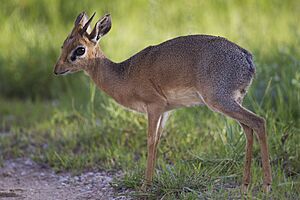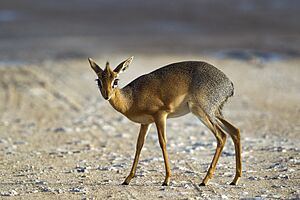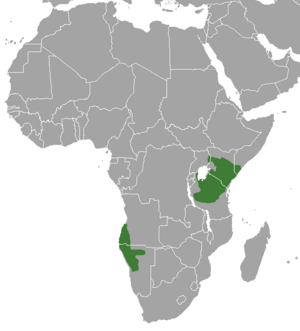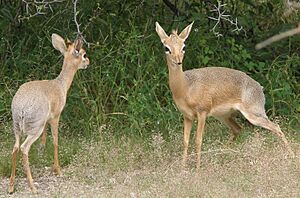Kirk's dik-dik facts for kids
Quick facts for kids Kirk's dik-dik |
|
|---|---|
 |
|
| Male | |
 |
|
| Female Both at the Etosha National Park in Namibia |
|
| Conservation status | |
| Scientific classification | |
| Genus: |
Madoqua
|
| Species: |
kirkii
|
| Subspecies | |
|
4 ssp., see text |
|
 |
|
| Range | |
The Kirk's dik-dik (Madoqua kirkii) is a tiny antelope that lives in Eastern Africa. It is one of four types of dik-dik antelopes. Scientists believe there are at least four different kinds, or subspecies, of Kirk's dik-dik. These small animals are plant-eaters (herbivores). They are usually a fawn color, which helps them blend in with their savannah homes. Kirk's dik-diks are very fast, able to run up to 42 kilometers per hour (about 26 miles per hour). In the wild, they usually live for about 5 years, but some can live for more than 10 years. In zoos, they can live even longer, with males living up to 16.5 years and females up to 18.4 years.
Contents
What Does "Dik-Dik" Mean?
The name "dik-dik" comes from the sound they make! When these antelopes feel scared, they hide low to the ground. If a predator finds them, they run away very fast in a zig-zag pattern. They keep running until they find a safe place in thick bushes. While they run, they make a loud, trumpet-like "zik-zik" sound. This sound warns other dik-diks about danger. It also tells predators that a pair of dik-diks lives there.
What Do Kirk's Dik-Diks Look Like?
Dik-diks are some of the smallest antelopes in the world. The Kirk's dik-dik is the largest of them. It stands about 14 to 18 inches (35 to 45 cm) tall. It weighs no more than 7.2 kilograms (about 16 pounds). Female dik-diks are usually a little heavier than males.
These animals are very delicate. They have a pointed, wiggly nose and big eyes and ears. They also have special glands near their eyes. Their legs are thin like pipes, and their back legs are much bigger than their front legs. They have a tiny tail that is barely there. Their fur can be gray or gray-brown. Their sides, legs, and a crest of hair on their head are tan. The fur around their eyes, inside their ears, and on their belly and rump is whitish.
Male Dik-Dik Horns
Only male dik-diks have horns. These horns are about 3 inches (8 cm) long. They have ridges and point backward. The bottom half of the horns has seven to nine rings. These rings are often hidden by the hair crest on their head.
Differences Between Males and Females
Male and female Kirk's dik-diks look a bit different. This is called sexual dimorphism. Females are larger and do not have horns. Males have a more developed snout and a longer hair crest. They also tend to be lighter in color. It can be hard to tell Kirk's dik-diks apart from Guenther's dik-diks. But Kirk's dik-diks have a shorter nose area, which makes their head look more wedge-shaped.
How Do Kirk's Dik-Diks Survive in Dry Places?
Kirk's dik-diks are very good at living in the dry areas of eastern Africa. They have a special nose with tiny, slit-like nostrils. This nose has a large chamber inside with lots of blood. When they pant quickly through their nose, the air cools the blood. This cool blood then goes back into their body. This process also helps them save water, as very little water is lost when they breathe out.
They also save water and energy in other ways. Their body temperature can change, and their body uses less energy. These things help them survive in hot, dry places. They even save fluids by licking dew off their nose. They also get water back from their waste. Compared to cows, dik-diks have very few sweat glands.
Daily Habits for Survival
Dik-diks are mostly active at night. During the hottest parts of the day, they rest in the shade. This helps them avoid losing valuable body fluids. They are also very picky eaters. They choose to eat juicy plants, herbs, and leaves that give them the most water. Their back legs are longer and stronger than their front legs. This might help them push forward and climb over rough ground more easily.
Where Do Kirk's Dik-Diks Live?
Kirk's dik-diks live in the savannah areas of eastern and southwestern Africa. They are found in patches because they need specific types of homes. In Namibia, they live in separate areas along the Fish River. They do not live in the Namib desert itself. However, they might cross desert bushes if there is water nearby.
They like places with good cover, like bushes, but not tall grass. Their perfect home has many different plants to eat. It also needs lots of shade and open space at their eye level. If the grass grows too tall and blocks their view, they will move to a new area. Their homes usually have a mix of thick bushes and very little short grass.
Living in Pairs and Defending Their Home
Dik-diks live in pairs and stay in their own territory. These territories can be from 2 to 86 acres in size. The size depends on how much cover and food is available. If nothing bad happens, a pair of Kirk's dik-diks might live in the same territory for their whole lives. The male dik-dik is the main defender of their home. Females cannot protect the territory by themselves. Fights over good territory are not common. But when they do happen, males will charge at each other. They stop just before touching. Then they run from a longer distance and repeat the charge. The fight ends when one male gives up. Both males then scratch at the ground.
What Do Kirk's Dik-Diks Eat?
Dik-diks are herbivorous animals, meaning they only eat plants. Their diet mainly includes leaves, fruits, new shoots, and berries. Because of their special adaptations, dik-diks do not need to drink water. They get all the water they need from the plants they eat.
Kirk's dik-diks are very picky eaters. They choose plants that are easy to digest. These plants are high in nutrients and water but low in tough fibers. They only eat grass when it is just starting to grow. Their stomachs are quite large when full, but they can shrink a lot when empty. Because they need a lot of food, Kirk's dik-diks eat and digest food often, both day and night. They eat about 3.8% of their body weight every day.
Life Cycle and Behavior
Like other small antelopes, Kirk's dik-diks live in pairs that stay together for life. This is called monogamous behavior.
Reproduction
Female Kirk's dik-diks are pregnant for about 5 to 6 months. They can have up to two babies (offspring) each year. Females can have babies when they are 6 to 8 months old. Males are ready to mate when they are 8 to 9 months old. Dik-diks usually have only one baby at a time. Most babies are born between November and December, and again between April and May. This time matches up with the rainy seasons.
Dik-dik babies are born differently from other similar animals. Their front legs are tucked along their body, not stretched out. After birth, the baby hides away from its mother for 2 to 3 weeks. About half of the baby dik-diks survive. Once the baby is older, it joins in with the parents' bonding rituals. It stays with its parents until another baby is born. At that point, the parents chase the older sibling out of their territory. The older dik-dik then goes to find its own territory and a mate.
Who Are Their Predators?
Many animals hunt dik-diks. These include eagles, wildcats, jackals, caracals, leopards, hyenas, cheetahs, Cape wild dogs, honey badgers, crocodiles, pythons, lions, monitors, and humans. Young dik-diks are often hunted by baboons, genets, and eagles.
Dik-diks have excellent hearing, sight, and smell. When they sense danger or hear other animals' alarm calls, they hide instead of running. They only make their famous "zik-zik" alarm call when they are truly scared or disturbed.
How Do Humans Affect Dik-Diks?
Humans are the biggest threat to dik-diks. People sometimes hunt them for their hides (skin) and bones, often using traps. The bones from their legs and feet are used to make traditional jewelry. Their hides are turned into soft suede gloves. It takes an entire dik-dik hide to make just one glove! Some local hunters do not like dik-diks. This is because their alarm calls can warn larger animals that humans are nearby.
Dik-diks can also benefit from some human activities. When people use "slash-and-burn" farming, it clears old plants. New shrubs then grow, which are a good food source and hiding place for dik-diks. The IUCN Redlist, which tracks animal populations, says that Kirk's dik-dik is of "least concern." This means their population is stable and not currently at risk.
Types of Kirk's Dik-Dik
There are usually four main types, or subspecies, of Kirk's dik-dik. Some scientists think these might even be separate species!
- M. k. kirkii Günther, 1880
- M. k. cavendishi Thomas, 1898 – Cavendish's dik-dik
- M. k. damarensis Günther, 1880 – Damara dik-dik
- M. k. hindei Thomas, 1898
Images for kids
-
M. k. damarensis
female, Etosha National Park, Namibia -
Family, Lake Manyara, Tanzania
-
Male, Etosha, Namibia







